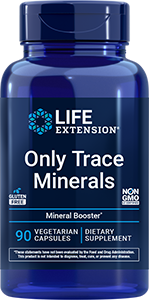
Soil Degradation: Why You Might Not Be Getting Enough Nutrients from Your Food
Published: March 2025
You probably assume that when you eat fruits and vegetables, you're getting the vitamins, minerals and other nutrients you need to stay healthy. Especially if you consume the USDA-recommended 5-7 servings a day. But did you know that today's apples, carrots, green beans and other plants simply don't pack the same nutritional punch they did decades ago?
The culprit: poor soil quality. Yes, the dirt your food is planted in does matter! Popular fruits like apples, oranges and bananas, as well as vegetables such as tomatoes and potatoes, have lost up to 25-50% of their nutritional density over the past 50 to 70 years. Changes in farming practices that have impacted soil quality, and led to soil degradation, may be to blame. Research published in a special issue of Foods in 2024 cites environmental factors and soil dilution for this nutrient loss.
This decline concerns experts worldwide because of its impact not only on the land, but also on the human body. Let's explore how soil affects your food's phytonutrients and how supplements could help bridge nutritional gaps.
Why do fruits and vegetables have fewer nutrients than they used to?
A number of factors impact how many nutrients you'll get from the produce on your plate:
- How it's prepared (raw, steamed, baked, fried, etc.)
- Where on the land it's grown
- The genetic makeup of the plants
- Soil quality
While you can control how you prepare your food (raw and steamed beat fried), you'd have to go into a time capsule to control some of these other variables! If you know anything about farming, you know how much agricultural practices have changed in the past 60 years. Modern agriculture has significantly increased crop yields, but the practice has had its nutritional costs.
So, too, has the introduction of crop varieties that grow faster: These new and "improved" plants tend to be less nutrient-packed than the slower-growing kinds.
What nutrients are missing from today’s fruits and vegetables?
An analysis of the mineral content of fruits and vegetables from the UK's Composition of Foods Tables shows dramatic declines in essential minerals from 1940 to 2019, including:
- Sodium: Decreased by 52%
- Iron: Decreased by 50%
- Copper: Decreased by 49%
- Magnesium: Decreased by 10%
And the loss isn't limited to the UK. Studies in many countries have shown taste and nutrient density loss in fruits, vegetables, and food crops during the past five to seven decades. They tracked decreases not just in the minerals mentioned in the UK report but also in potassium (16 to 19%), calcium (16 to 46%) and zinc (27 to 59%). Fortunately, you can easily supplement with minerals and other nutrients to fill in these gaps.
4 ways to make sure you’re getting optimal daily nutrition
With our healthiest foods having fewer nutrients, is there anything we can do to stay properly nourished? Yes, there is!
- Eat a wide array of plants. Consider this hedging your bets. Add fruits, vegetables and legumes of all different colors, textures and shapes. Increasing both the quantity and the diversity of what's on your plate is a great (and delicious) insurance policy.
- Choose local farmers where possible. Or grow your own garden! (It just takes one tomato plant to realize how different a home-grown crop is compared with the large, shiny veggies you see in the supermarket.)
- Take lab tests periodically to check on the status of your nutrition.
- Have a solid vitamin and supplement routine. Dietary supplements may help to fill those gaps and support your long-term wellness.
Should you take multivitamins?
According to the CDC, only 10-12% of Americans eat enough fruits and vegetables per day. If you're in this elite bracket, you still may not be getting the amount of nutrients you need because of the degradation of soil. Quality supplements help make up for less nutrient-dense foods and deliver optimal levels of the nutrition you need. They are important for those whose diets could use more plant-based foods, as well as those whose menus are overflowing with salads and veggie omelets.
A good multivitamin, formulated to target the most common nutrient deficiencies, can pick up where your daily diet leaves off. You want to ensure you're getting the full spectrum of essential vitamins, minerals and other nutrients in amounts that meet or exceed the Recommended Dietary Allowance (RDA) for nearly every nutrient that has an RDA. By getting the recommended amounts daily, you can ensure you're getting what you need to live your best health.
Studies have shown that multivitamins support aspects of health that matter the most to many people. Research from the COSMOS clinical trial demonstrated that a daily multivitamin promotes brain health and memory and cognition.
A top-of-the-line multivitamin will also support cardiovascular and blood vessel health, promote healthy immune function and cellular health, and quench free radical activity in your body that causes oxidative stress. Supplements with lutein and zeaxanthin also encourage eye health as you age.
Explore Our Best General Health & Wellness Supplements
Soil Degradation: Causes and Solutions
So why is soil declining in quality? According to a report in Nature, here are the top five reasons.
1. Fewer trees
Trees are vital to ecosystems, and their roots provide a physical barrier to soil erosion, protecting soil from wind and water. Deforestation has left soil vulnerable to the effects of harsh weather, such as wind or heavy rain.
2. Climate change
Changes in temperature, precipitation patterns, and extreme weather events that accelerate soil erosion and diminish soil fertility also disrupt the natural processes that replenish the soil. Climate change is believed to contribute to worldwide soil degradation.
3. Pollution
Pesticides, synthetic fertilizers, heavy metals and industrial pollutants can make soil less fertile and reduce its biodiversity.
4. Urban development
In paving paradise and putting up parking lots, we've lost a lot of natural vegetation. Buildings and roads, dams and hydroelectric plants, and even modern farms alter water runoff patterns that contribute to soil pollution and erosion.
5. Monocropping
Growing the same crop over and over again on the same soil—like wheat, soybeans, or corn—is called monocropping, which drains the soil of specific nutrients. (Overgrazing has a similar effect; it messes with the soil structure and microbial life.)
What can be done to prevent soil degradation?
Fortunately, the list of potential solutions to soil degradation is a lot longer than the list of causes! According to the USDA, the following sustainable farming practices offer a glimmer of hope for the fruits and vegetables of the future:
Crop rotation:
Changing the crops you grow in a field from season to season to keep the soil healthy and reduce pests.Protect crops:
"Cover cropping" is the practice of planting a crop simply to cover the soil (not for harvesting). This protects the soil from erosion and increases its fertility.Go easy on the plow:
Reducing how much you plow or disturb the soil (known as "tillage") will help keep its structure intact and prevent erosion.Composting:
The remnants of food and other natural waste can be composted, creating a fantastic fertilizer that can enrich the soil with nutrients and boost microbial activity, which is great for soil health.More trees, please:
Adding trees to farmland (agroforestry) can help improve biodiversity by providing habitats for beneficial organisms and reducing erosion.Deep-rooted plants:
Plants with deep roots (like trees and perennial plants) can strengthen soil structure and access nutrients deeper in the ground, unlike shallow-rooted grasses.
Looking toward the future, scientists are working with farmers to develop these sustainable farming practices and improve degraded soils to help create nutrient-rich food crops. And on a smaller scale, homeowners can contribute to biodiversity and healthy soil using the same sustainable agriculture techniques in their own backyards and gardens.
Be your best, most nourished self
If you're looking to boost your nutrition, obviously, your diet is the most important place to start. To get more from your food, consider experimenting with creative recipes that bring more fruits and vegetables to your table. For instance, enjoy roasted veggies rich in vitamins and antioxidants for a fun and colorful side dish. Also, explore high-protein vegetables like lentils, broccoli, and spinach to create delicious dishes that may improve muscle health, satiety and overall vitality.
Remember, also, that regular exercise is key to physical and mental fitness, as is quality sleep. By taking a holistic approach to your health, you can protect yourself against the negative effects of soil degradation.
Want to claim the health benefits of well-rounded nutrition, but not sure where to start? Our health needs quiz delivers personalized recommendations for your lifestyle.
About the Author: Carlie Bell, ND, is a licensed Naturopathic Physician and adjunct medical instructor at Saint Louis University. Dr. Bell is also the program director of the American College of Acupuncture and Oriental Medicine.
References
- Bhardwaj RL, et al. "An Alarming Decline in the Nutritional Quality of Foods: The Biggest Challenge for Future Generations' Health." Foods. March 2024. https://pubmed.ncbi.nlm.nih.gov/38540869/
- Davis DR, et al. "Changes in USDA food composition data for 43 garden crops, 1950–1999." J. Am. Coll. Nutr. 2004. https://www.tandfonline.com/doi/abs/10.1080/07315724.2004.10719409
- Fan MS, et al. "Evidence of decreasing mineral density in wheat grain over the last 160 years." J. Trace Elem. Med. Biol. 2008. https://www.sciencedirect.com/science/article/abs/pii/S0946672X08000679?via%3Dihub
- Farooqi ZUR, et al. "Management of Soil Degradation: A Comprehensive Approach for Combating Soil Degradation, Food Insecurity, and Climate Change." Ecosystem Management: Climate Change and Sustainability. November 2024. https://onlinelibrary.wiley.com/doi/abs/10.1002/9781394231249.ch3
- Kathi S, et al. "A decade of improving nutritional quality of horticultural crops agronomically (2012-2022): A systematic literature review." Sci Total Environ. February 2024. https://pubmed.ncbi.nlm.nih.gov/37992822/
- Kraamwinkel CT, et al. "Planetary limits to soil degradation." Communications Earth & Environment. December 2021. https://www.nature.com/articles/s43247-021-00323-3
- Lampousi AM, et al. "Vitamins C, E, and β-Carotene and Risk of Type 2 Diabetes: A Systematic Review and Meta-Analysis." Advances in Nutrition (Bethesda, Md.). March 2024. https://pubmed.ncbi.nlm.nih.gov/38493875/
- Lee SH, et al. "Adults Meeting Fruit and Vegetable Intake Recommendations — United States, 2019." CDC. January 2022. https://www.cdc.gov/mmwr/volumes/71/wr/mm7101a1.htm
- Mayer AM, et al. "Historical changes in the mineral content of fruit and vegetables in the UK from 1940 to 2019: a concern for human nutrition and agriculture." International Journal of Food Sciences and Nutrition. October 2021. https://www.tandfonline.com/doi/full/10.1080/09637486.2021.1981831
- Thomas D. "A study of the mineral depletion of foods available to us as a nation over the period 1940 to 1991." Nutr. Health. 2003. https://journals.sagepub.com/doi/10.1177/026010600301700201
- Vyas CM, et al. "Effect of multivitamin-mineral supplementation versus placebo on cognitive function: results from the clinic subcohort of the COcoa Supplement and Multivitamin Outcomes Study (COSMOS) randomized clinical trial and meta-analysis of 3 cognitive studies within COSMOS." The American Journal of Clinical Nutrition. January 2024. https://pubmed.ncbi.nlm.nih.gov/38244989/
- "Cover Crops and Crop Rotation." U.S. Department of Agriculture. https://www.usda.gov/about-usda/general-information/initiatives-and-highlighted-programs/peoples-garden/soil-health/cover-crops-and-crop-rotation
Always be in the know!
Access the latest deals, wellness news, expert health tips & more!











